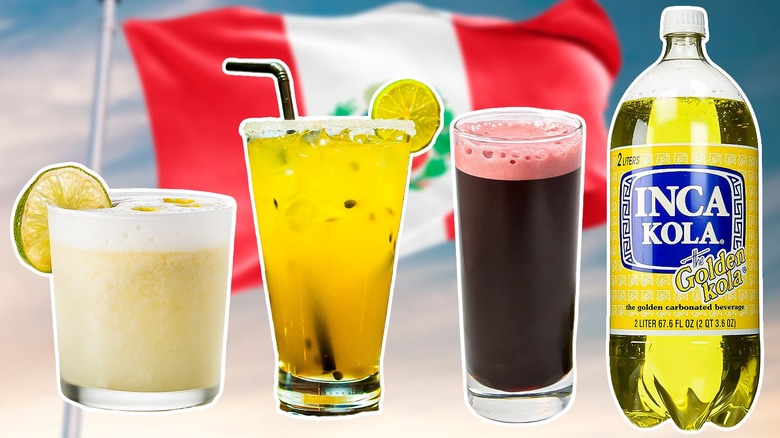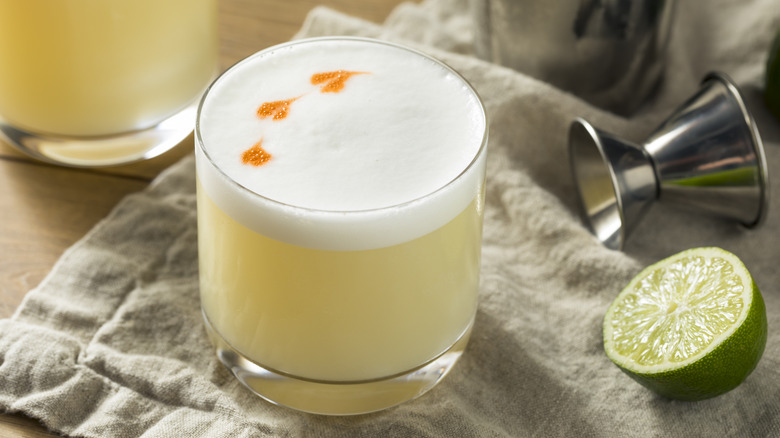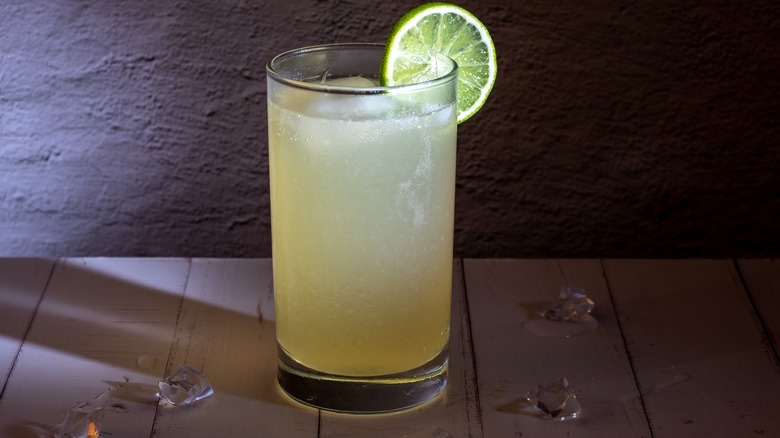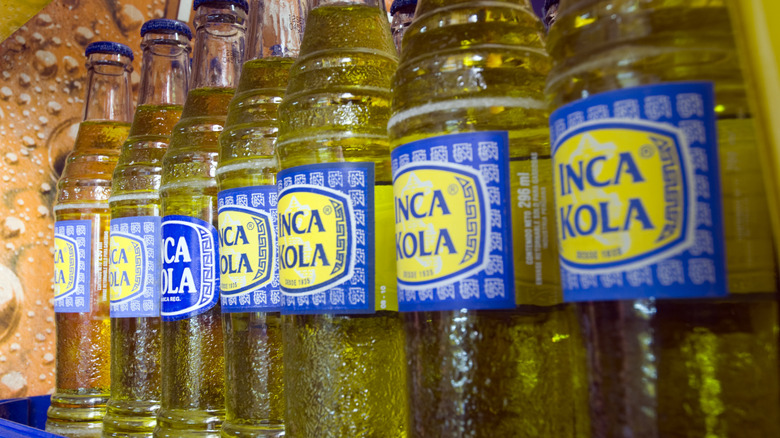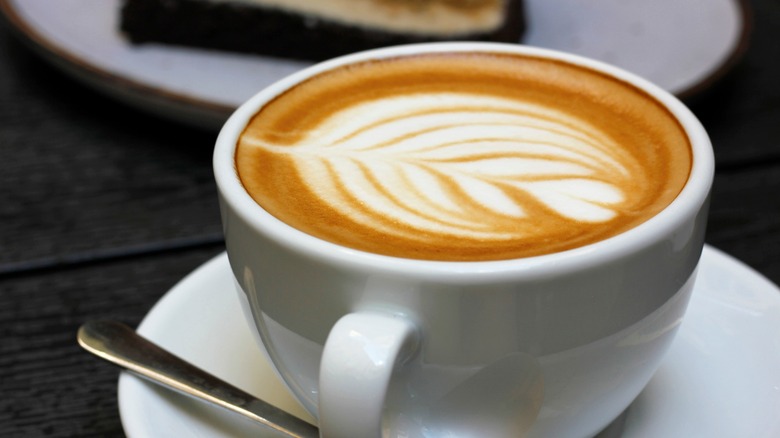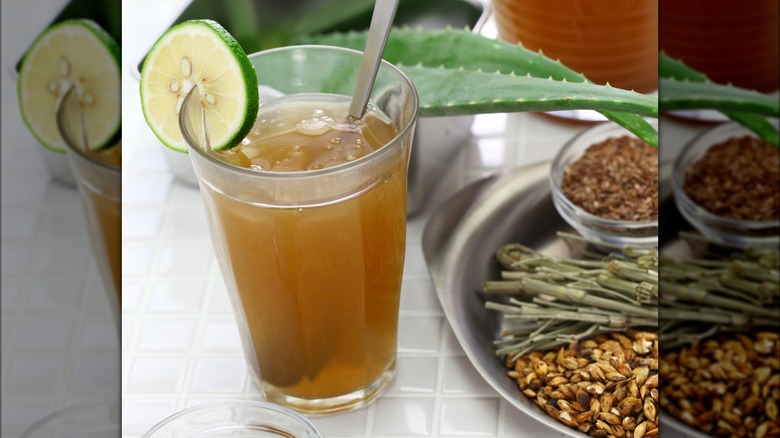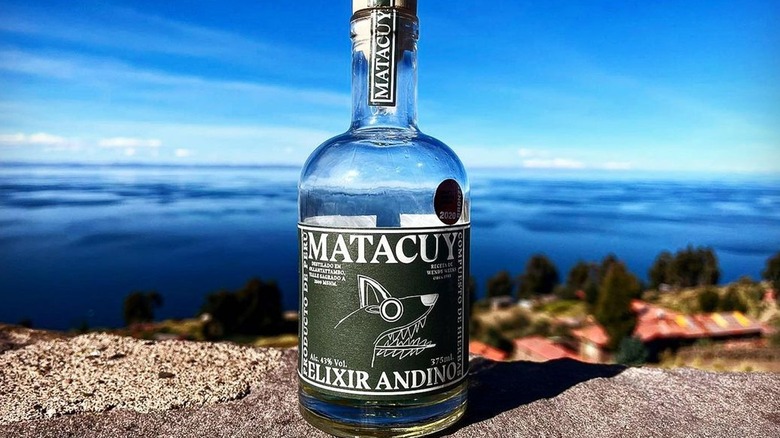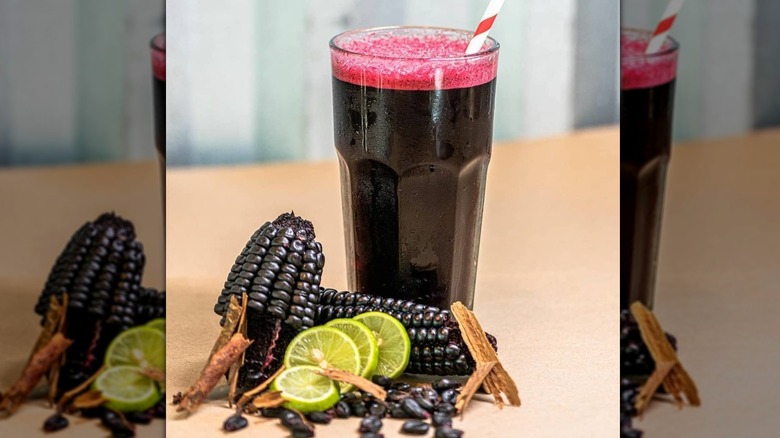8 Drinks To Try In Peru, According To A Peruvian Chef
There are many reasons why Peruvian cuisine has become world famous. Mostly, though, it comes down to flavor. A varied geography of towering mountains, deep jungles, dry deserts, and a Pacific coast births innumerable ingredients. Throughout its pre- and post-Columbian history, the plants and animals harvested for food across Peru have shaped the tastes the country is known for. Yet, cuisine is about more than what we can nosh; people need something to wash it all down with. Regardless of if you're filling a mug, cup, or glass, the bounty of Peru provides.
You likely know about the country's most famous beverage, pisco, but there's a lot more to sip on. Chef Victoriano Lopez agrees. As the executive chef of La Mar San Francisco and a native of Ancash, Peru, Lopez holds a lifelong mission to share his nation's cuisine. That includes beverages. "Peru is a country renowned for its rich culinary heritage and diverse cultural traditions," he tells Tasting Table, "The beverages found within its borders are no exception."
I recently spent three months in Peru, and the amount of drinks at any given bar, restaurant, or bodega never failed to stun this thirsty patron into submission. To dive into the bevvy culture of Peru, I asked chef Lopez for some insight and firsthand experience. As Lopez notes, "Whether sipped in a bustling market, shared with friends and family, or savored in a quiet moment of reflection, these beverages offer a window into the heart and soul of Peru."
1. Pisco and pisco sours
Without a doubt, pisco is the most popular — or at least well-known — Peruvian drink. Its presence in bars is so widespread that chances are you've already tried it even if you haven't visited Latin America. Pisco is a type of brandy. As chef Victoriano Lopez attests, it's the key ingredient in the lime-kissed pisco sour, a cocktail made by combining the spirit with citrus juice, sweetener, and egg white.
While the origin of that mix is disputed (neighboring Chile also lays claim to creating pisco), Lopez is eager to remind the parched among us that pisco isn't just a delicious tipple but one steeped in Peru's history: "Pisco, in particular, holds a revered position," he says, "with its origins tracing back to the colonial era and the Spanish brandy-making techniques introduced during that time."
True enough, pisco is widely acknowledged as having originated in Peru following the Spanish invasion of 1532. Both grapevines and distilling techniques were brought after colonization, as were imports of brandy from the European continent. Eventually, creating a homegrown product took precedence. Today, pisco is a regionally protected product that comes in several forms, including the two most common: puro, pisco made with one type of grape, and acholado, a blend of specific grape varieties. By itself, pisco has a yellowish-amber hue and fragrant aroma that is indicative of the some 10-plus flavor profiles the spirit can possess. It's floral, botanical, and so well-regarded that there's even a national pisco sour day.
2. Chilcano
Pisco and pisco sours might seem an undeniable, incomparable combination. The cocktail is all at once tart, electric, and biting, the perfect beverage for hot weather. Yet, not everyone enjoys the taste of high acidity or the round texture of milky egg whites on a smothering warm day. Nor is drinking pisco straight the right option for all. Fortunately, there are other ways to try this drink in Peru. "[Pisco] also shines in the effervescent chilcano," notes chef Victoriano Lopez, " where it mingles with ginger ale for a refreshing, slightly herbal taste."
The chilcano is a rousing Peruvian cocktail that's definitely worth the effort to seek out, though you won't have to look very far at all. It's super popular at bars across the country; some mixologists attest that it's actually more popular than its shaken egg white cousin. A basic chilcano recipe consists of pisco with ginger ale, lime juice, and bitters. The result is exactly as Lopez describes it: the burn of ginger, complemented by the high vibes of citrus, each accentuating the vinicultural traits of Peruvian pisco.
The nature of the chilcano makes it an ideal drink to sip in a number of circumstances. Perhaps the best is alongside some of Peru's famous fish dishes, like a fish soup which has the same name. Order a bowl of chilcano with a glass of chilcano, and you've got yourself a citrus-packed pair of liquids to sup on, a true highlight of what Peru has to offer.
3. Inca Kola
Peru obviously has a standout cocktail and spirit culture, but some of the most fun and interesting drinks I tried while traveling through the country had nothing to do with alcohol. Inca Kola is one such beverage. Chef Victoriano Lopez says that "the vibrant Inca Kola, with its unique citrus-vanilla flavor, is deeply woven into the fabric of Peruvian identity." It definitely is.
The presence of this native soda is ubiquitous: You can buy it in every grocery store or convenience market, it's slung by vendors patrolling the beach looking for dry-mouthed sunbathers, and it's sold at snack carts that are stationed on nearly every major street corner in Lima. (It's even possible — but not recommended — to buy a bottle right off said street from your taxi window as enterprising hawkers walk through traffic.) Nearly every laborer you pass has an Inca Kola or two nestled into a plastic sack, and the soda is regularly offered by restaurants in glass containers large enough to split among an entire family.
Unlike Coca-Cola, you won't see Inca Kola used as a mixer. It has a very distinct flavor, as Lopez touched on. The intended result of citrus and vanilla is contested by many who unscrew the cap. Inca Kola has been described as bubblegum-like; I find it akin to the taste of cream soda. The golden color is meant to draw your eye, and you shouldn't leave Peru without giving it a taste.
4. Manjar blanco and café pasado
Although Peruvian coffee isn't as widely exported as that of neighboring Colombia or Brazil, the nation's farmers grow some of the best beans I've had the pleasure of tasting throughout my time eating and drinking in 20-plus countries. Luckily for caffeine connoisseurs, that status is changing; fair-trade, organic Peruvian coffee is becoming more widely seen in third- and fourth-wave shops. Peruvian coffees are grown at both high and low altitudes, with beans of the latter having a profile that is round, rich, and robust rather than highly acidic or heady. That suits them perfectly to two unique java traditions of Peru: coffee with manjar blanco, and café pasado.
"The manjar blanco latte offers a delightful fusion of Peruvian and global influences," says chef Victoriano Lopez, "blending the creamy sweetness of the country's iconic manjar blanco with the familiar comfort of a latte." Manjar blanco is a caramelized sugar spread similar to dulce de leche, but it's thicker, more golden, and less sugary. Some coffee houses will offer it as a sweetener to your daily cup, imparting a deep flavor that burnishes the attributes of low-altitude beans.
On the flip side is the café pasado technique. This is a brewing method rather than a drink. A mash-up of drip and pour-over coffee, pasado uses a double-chambered device wherein the grinds and hot water are mixed to make a thick extract, which is then thinned with hot water.
5. Quinua carretillera
For chef Victoriano Lopez, the beauty of sipping any drink in Peru is that it has the potential to reveal so much about the country's abundance. "The beverages of Peru reflect the region's diverse agricultural bounty," he says. Specifically, he points to a hot breakfast beverage as an example of this. "Such as the quinua carretillera," he continues. "[It's] a nourishing drink made from the prized superfood quinoa, known as the breakfast of the people."
Quinoa is a grain that's native to the border of Peru and Bolivia, where it has been consumed by indigenous people for centuries — long before colonists arrived and capitalism began exploiting farmers in an effort to churn it out to markets across the world. Globalization has had significant impacts on the sustainability of quinoa. Still, the locality of it to Peru makes it something you should consider trying on a visit to the country.
Served from street carts at breakfast, the warm (at times, piping hot) drink is made from cooked, sweetened quinoa mixed with fruit, water, sometimes milk, and often spices. In its complete essence, quinua carretillera is more than just a drink; it's a substance that can keep you full and nourished from the early morning till late afternoon. Every vendor makes theirs a bit different. One corner may serve a cup with chunks of apple or pear, while another serves straight-up hot and brothy grains. This Peruvian drink tastes earthy, slightly grassy, and like a slurp of history.
6. Emoliente
Emoliente is a sort of barley tea that, like quinua carretillera, can be purchased hot from street carts across the cityscapes and towns of Peru. Asked what emoliente means to Peruvian cuisine, chef Victoriano Lopez relays that, "emoliente and emoliente piteado [are] soothing herbal infusions that have long been prized for their medicinal properties."
To make emoliente, barley is toasted for color and to activate nutrients. Then, the barley water is fortified with herbs and plants deemed to be of culinary and medicinal value, such as lemongrass, flax, and chamomile stems. The mixture stews in a giant well at the center of a steel pushcart, where an emolientero then mixes each cup with more botanicals and shrubs before selling it to patrons who line up around the block in the mornings. These emolienteros often belong to associations that have enshrined the process and protect this important point of national culture, though the recipes for emoliente can differ from cart to cart. Emoliente has a slightly sweet flavor that can also be woody and complex, and a texture that's slightly thick.
Although it's typically consumed in the early morning, once upon a time, emoliente carts used to stay open until the wee hours, when emolienteros would sell emoliente piteado, an alcoholic version that included pisco or rum. This practice is now rare, due to local laws outlawing on-street alcohol sales. Still, there are bars, like Lima's La Emolientería, where the heritage beverage is sold spiked with spirits.
7. Matacuy
"Matacuy is a digestive made of botanicals which is natural, complex, and balanced," chef Victoriano Lopez explains. Despite its varied taste, it does not have the name recognition of other beverages that are customary to Peru. Rather than being a generic drink that can be found easily across Peru, Matacuy is specific.
The spirit is produced by distillers in the Sacred Valley of Peru, where guinea pig, or cuy, is regularly consumed. Along with cuy raised for meat, the region has a distinctive microclimate that nurtures unique herbs, flowers, fruits, and spices that grow only here. These plants are used in the pre- and post-fermentation of Matacuy. The base spirit is distilled from sugarcane, but at any given time, it can be augmented with 12 to 50 different botanicals, providing a layered, nuanced, new taste with each sip. The flavor belies its power. Matacuy, which means "kill the guinea pig," is 43% alcohol. That bite brings power. Per chef Lopez, the satisfying burn is "great after an evening of ceviche and lomo saltado."
8. Chicha morada
It's become a fun fact for the food-focused among us to know: Peru has over 4,000 varieties of potatoes. What's lesser known is that the country also has more than 50 types of corn, one of them being the dark purple variety used for an iconic drink of Peruvian cuisine. "Let's not forget the deep purple chicha morada," says chef Victoriano Lopez, "a vibrant corn-based beverage that serves as a refreshing link to the country's pre-Columbian past."
Chicha is a fermented corn beverage that has been produced in the Andes for thousands of years. Evidence of the drink being ritually consumed in Peru predates the Incas. Traditionally, masticated corn was spit into a ceramic container, where saliva turned it to sugar before it was fermented and boiled down and consumed for ceremony and celebration. Today's chicha is made with maceration instead. Dried purple corn is combined with cinnamon, clove, and sugar. Once it's boiled down, chicha morada is given some fruit and lime juice and served cold. It's a sweet beverage reminiscent of mulled wine, but with less tannins and stone fruit, heavier on the fieldish, sweet-milky minerality of a native corn variety. Chicha morada can be found in most restaurants across Peru. As chef Lopez reminds us, a refreshing glass should never be overlooked.
